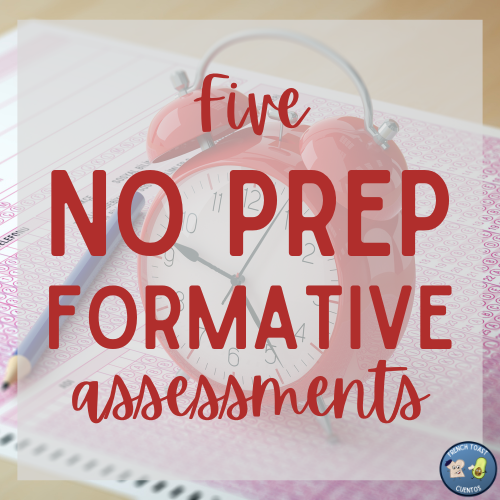Simplify your grading with these four tips
Grading student work is one of those tasks that always seems to pile up, doesn't it? I often find myself putting it off, only to end up with a mountain of assignments to tackle. I'd much rather spend my time creating new materials and activities for my students. Over the years, I've found some strategies that have helped me simplify and speed up the grading process. Here are five tips that might help you streamline your grading too.
1. Use self-grading Google Forms
Google Forms are a lifesaver for culture assessments. At the end of units on Regions of France, Quebec, and famous Francophones, I use these forms to assess my students. I assess students’ reading, listening and writing skills in French but I also want to assess students in English on the information they learned about the topic. I tell students how many points they need to pass . Students get immediate feedback and can retake the form if needed. All I have to do is look at the overview of their scores and enter them into PowerSchool. The best part? The entire assessment is completed and graded within the same class period—no papers to lug home, no extra prep.
2. Leverage games as quizzes
Games like Gimkit are not just for review—they can be great formative assessments too. My students love Gimkit, and it's a fun way to reinforce vocabulary. You can use the percentage correct at the end of the game to gauge their understanding. This is especially useful for novices who are still at the word recognition stage. For more advanced students, you can include different types of questions to make the game more challenging. It's a win-win: students enjoy the game, and you get a quick and easy way to assess their learning.
3. Get students to check and grade their work.
Writing assessments can be the most time-consuming to grade. To save time, I have students highlight and check their writing against a rubric before they turn it in. They color-coordinate their writing with the rubric, which makes it easier for me to see if they’ve met the expectations. This process not only speeds up grading but also helps students self-assess and improve their work before submitting it. This limits the number of students retaking assessments. Teaching them to highlight and self-check is an investment upfront, but it pays off in the long run.
Read more about how I did this activity with reading here, the same idea can be applied to writing.
4. Grade as you go
One effective strategy is to grade and check off work as students complete it. I give my students a stamp for each completed class activity in their packet. This keeps them on task and allows me to provide immediate feedback. At the end of the week, I can quickly tally the stamps to give a participation grade. I don’t have to remember if they did all the work. This method helps me keep track of their progress and reduces the stack of papers I need to go through later. Plus, it provides instant feedback, which is valuable for student learning.
Read our post on Five NO PREP formative assessments you can give and grade immediately.
5. BONUS: Reduce the amount you are grading
Do you really need to grade everything? No, you don’t. Some activities are just practice and part of the learning process. Focus on grading assignments that truly measure student progress. Check your school’s requirements to see how many grades you need to enter each week. My school requires updates every two weeks, so I aim to enter at least one grade in that period. Many of these can be participation and work completion grades. If an activity isn’t a good measure of progress, consider if it’s worth grading or if it can simply be checked off as collected.
Simplifying your grading process doesn’t just save you time; it allows you to focus more on what you love—teaching and creating engaging activities for your students. By integrating these strategies, you can make grading more manageable and efficient. Happy teaching!
shop here: CI Cuentos Store Madame French Toast
Join our Facebook group here: French Toast Cuentos World Language Collaboration








Looking for a fun brain break or time filler? Play Human Crepe! Get a link to a free download on my TPT store!